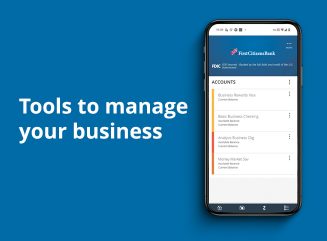Digital banking for business
Seamlessly access all of your accounts from one place with First Citizens Digital Banking for business.

Control your portfolio
Invest how you want, when you want, in real time with Self-Directed Investing.

Digital banking for business
Seamlessly access all of your accounts from one place with First Citizens Digital Banking for business.
See how we're supporting companies
We're committed to serving companies as they expand and succeed. The proof is in our success stories.
Q4 Quarterly Market Review: Available now
The Making Sense team reviews changes in the market during Q4 2025.
If you're experiencing the good fortune of having to figure out what to do with $1,000 extra in your bank account, it's cause for celebration. Your financial goals are waiting, and no matter your vision for the future, you can put that money to work today to help you get there. Here are four pathways you can choose from to invest $1,000 in yourself.

Experts recommend that you have 3 to 6 months' worth of living expenses stashed away for a rainy day. If you haven't started an emergency fund or need to top yours off, consider using your unexpected windfall to shore up your basic savings.
Having an emergency fund can help secure your financial future by giving you quick access to cash when you need it on short notice. When you use your cash savings, you avoid incurring credit card debt. This can help you protect your credit score for life's bigger purchases down the road.
If you have your emergency fund squared away, think about what's next among your financial goals. Whether it's a down payment for a house, a dream vacation or even putting money aside for retirement, that extra $1,000 can provide a big boost.
For life's major goals ahead, you could use your windfall to:
Every little bit you save now toward a big goal helps bring your dream into clearer focus.
If you're itching to reduce your debt load and have more money left over each month to save toward your goals, paying down debt might be just what to do with $1,000 extra in your bank account.
You could make a lump-sum payment toward your highest interest-rate debt or make several smaller payments to different loans or credit cards. You can even stash a little bit away in savings and put the rest toward your debt. In fact, it's a good idea to save and pay down your debts at the same time.
You don't have to have a lot of money to begin investing, so why not invest $1,000 in a portfolio of carefully selected stocks and bonds? If you've already met key financial goals like establishing an emergency fund, paying down your debt and saving for retirement for the year, you can meet with a financial professional to craft an investment plan tailored to your individual goals. From there, you'll have help selecting the best investments to match your needs.
Now you have multiple ideas for what to do with $1,000 extra in your bank account. Whichever path you choose, don't forget to set aside money each month to enjoy the life you're living while saving. A sound financial plan is all about building a life you love at every life stage.



This material is for informational purposes only and is not intended to be an offer, specific investment strategy, recommendation or solicitation to purchase or sell any security or insurance product, and should not be construed as legal, tax or accounting advice. Please consult with your legal or tax advisor regarding the particular facts and circumstances of your situation prior to making any financial decision. While we believe that the information presented is from reliable sources, we do not represent, warrant or guarantee that it is accurate or complete.
Third parties mentioned are not affiliated with First-Citizens Bank & Trust Company.
Links to third-party websites may have a privacy policy different from First Citizens Bank and may provide less security than this website. First Citizens Bank and its affiliates are not responsible for the products, services and content on any third-party website.
First Citizens Bank is a Member FDIC and an Equal Housing Lender icon: sys-ehl.
NMLSR ID 503941

Treasury & Cash Management
Electronic Bill Presentment & Payment
Investment & Retirement Services
Community Association Banking
Equipment Financing & Leasing
Credit Cards
Merchant Services
Email Us
Please select the option that best matches your needs.
Customers with account-related questions who aren't enrolled in Digital Banking or who would prefer to talk with someone can call us directly.